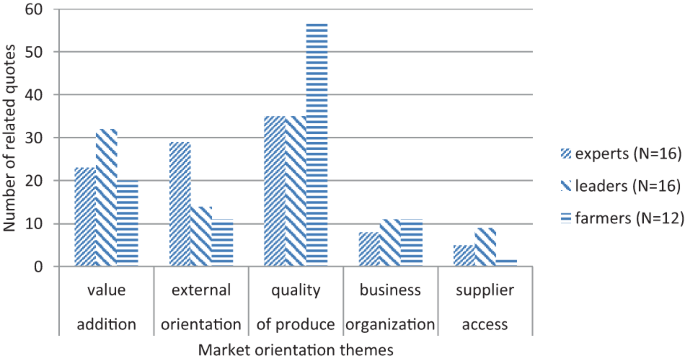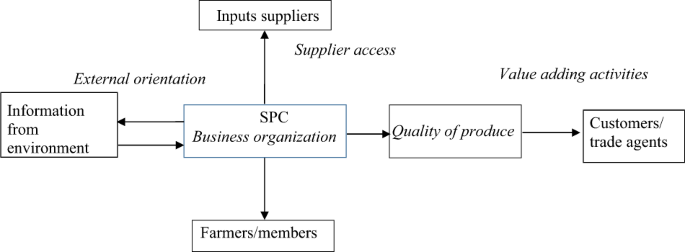
The concept of market orientation
The concept of market orientation understanding was expressed as a mix of more conceptual (“when do you consider your (/an SPC) to be market-oriented?”) and behavioral (“what activities does your (/should an SPC) do to be market-oriented?”) quotations which are combined in the analysis.
From the primary codes that we extracted from the interview transcripts, a clear pattern emerged in terms of twelve key topics (elements) of market orientation, which could further be classified into five major themes (see Table 1). These major themes of market orientation are described below in detail.
Quality of produce emerged as the dominant theme from the interviews. In a sense, seed quality refers to having the necessary elements of the seeds that customers want including good germination and moisture content, free from unwanted seed and inert materials, and high market value. Buyers require quality seeds to increase yields and obtain high incomes. It was expressed in a more/narrow product quality sense as the supply of quality product and in the value/economic sense as the supply of high market value products. At the level of individual quotes, quality of the produce was referred to as ‘focus on seed quality’, ‘provision of quality seed to the market’, ‘production of market demanded seed’, ‘production of improved seed’, ‘sufficient quality seed production’, ‘supply of quality seed for customers’, ‘timely provision of quality seed’, ‘work on providing quality seed production’, etc. Respondents stated:
“If we use all the required agricultural inputs and produce quality seed, I can say our cooperative is market-oriented.” (farmer11)
“Customers do not have any complaint on the seed that we delivered. In general, we are providing quality seed for our customers.” (farmer2)
Value-adding activities emerged as a second important theme in relation to the market orientation of SPCs. It was expressed in terms of internal activities such as seed value addition, external activities of the SPC in terms of selling the seed directly to customers and developing better market strategies, as well as the outcome level in terms of profitability. Profitability was emphasized as most respondents believe that profit is the key for the consistent growth of the business. Practitioners explained:
“… a cooperative is market oriented when it produces quality seed and sells its seed with reasonable profit.” (leader2)
“… a seed producer cooperative can produce improved quality seed and become profitable. It also obtains high income….. because of this its members and other farmers in the community can benefit from producing improved seed …” (farmer1)
In addition, several respondents expressed value-adding activities in terms of quotes related to ‘provide the seed with reasonable profit’, ‘sell the seed with profit’, and ‘when using value additions profitably’. Experts particularly linked the high profitability with the value-addition capabilities of the SPCs. For example, one expert said:
“I can say a given cooperative is market-oriented when the seed (it produces) is cleaned and sold directly to its customers by its own capacity…. it can obtain higher prices and become profitable by packaging its own seed.” (expert2)
External orientation came out as a third key theme of market orientation in SPCs and basically relates to the concept of information-based competitive advantage in the market place. External orientation covers the topics of access to market information, customer focus, and competitor orientation. Results show that most SPCs are more customer-focused rather than competitor-oriented. Several respondents shared the opinion that the SPCs should try to satisfy their customers and should be customer-oriented. It was mentioned by the respondents that customers are satisfied when they get what they want, which in turn will turn them into loyal customers. For example:
“… for SPC to be market oriented first it should collect information about the benefit of seed production and marketing. Then, it should produce seed that customer farmers need…. able to process and pack accordingly. If SPC is in a position to do all these activities, I can say the cooperative is market-oriented.” (expert4)
“… Furthermore, from a marketing point of view the cooperative should know in advance who really demands its seed, when they need the seed, which quality standards, and the amount of the seed they want to buy …” (expert5)
“In addition, I can say a cooperative is market-oriented when it is able to process and pack its seed by itself and satisfy its customers. Customers can only be satisfied when we deliver quality seed …” (leader4).
Business organization came out as a relevant theme, although less frequently articulated than the previous themes. It relates to the performance of the SPC in terms of it being a well-organized and managed cooperative with committed and capable members who are professionally disciplined to supply quality seed. Most respondents emphasized that SPCs should be well organized and their members should be committed to becoming profitable and stay in the business. For example:
“Our cooperative is working hard to produce and maintain quality seed …” (leader9)
“We have our own bylaws to maintain the seed quality.” (farmer12)
At the more specific level of quotes, the business organization was expressed in such terms as ‘strong relationship with partners (i.e. supporting organizations)’, ‘when SPCs are able to obtain support from partners’, ‘when SPCs are able to develop a plan for quality seed production and marketing’. Moreover, respondents explained the commitment in terms of high member participation, and members’ integrity and hard work.
Supplier access is the final theme that emerged from the interviews, reflecting the important task of cooperatives to ensure access to inputs and services for their members to enable them to produce the required quality and quantity of seed. Cooperatives are supporting their members to access the necessary inputs and services at the right time and at the desired level, which was expressed by respondents as inputs and services access for members. The argument centers on access to basic seed. Because of the high basic seed shortage in the country, the SPCs usually approach partners (agriculture office, cooperative promotion office, research institutes, public seed enterprises, seed-related projects, etc.) to get support to access basic seed from available sources. Respondents explained:
“In general, SPCs should access quality basic seed from seed sources and distribute it to their members.” (expert10)
“We accessed basic seed from seed sources through the support of district offices of agriculture and cooperative promotion.” (leader5)
Experts’ vs. practitioners’ interpretation of market orientation
Figure 1 shows the occurrence of quotes related to the five themes of market orientation in the context of Ethiopian SPCs as obtained from three respondent categories. From the occurrence of quotes (relative number of quotes within each of the five themes), several similarities and differences stand out. First of all, the quality of produce is seen as the dominant element of market orientation for all respondent groups but is particularly prominent in the perception of farmers/members. Experts emphasize external orientation as a crucial element of the market orientation concept much stronger than the SPC leaders and member farmers. SPC’s value-adding activities are perceived by all respondent groups as an important component of market orientation, but more so by SPC leaders than by member farmers and experts. All groups see business organization as a component of market orientation without too much distinction between respondent groups. Access to seed is seen as a less central element of market orientation, although more prominent by leaders than by experts and particularly farmers.

Response pattern of experts, leaders and farmer members on market orientation themes.
Overall, when reflecting on market orientation as a general concept in the context of SPCs, experts, and practitioners do agree on five key themes, although they do emphasize specific themes to different degrees. We developed the conceptual model shown in Fig. 2 on the basis of this qualitative research. Business organization leads to better access to inputs from potential suppliers. Inputs may include seeds, fertilizers, and agrochemicals, but centrally focuses on accessing basic seed from certified suppliers such as research centers, universities, and big seed companies. Sometimes SPCs’ access to basic seed depends on the business-to-business relationship with suppliers. Well-organized SPCs have strong relationships with suppliers, which results in accessing the right input at the right time. The business organization also contributes to better-coordinating members of the cooperatives. SPCs search for and provide the necessary inputs to their members to satisfy their basic seed demand and help them to produce the best quality seed that customers need. The quality of seed can influence buyers to pay higher prices and contribute to a higher market share. The business organization also links with gathering relevant information from the environment in terms of customers’ needs and competitors´ actions. It also depends on the organizational capacity of the cooperative to disseminate the information gathered to members and respond accordingly. Business organization also leads to more customer satisfaction by adding value to the product. Value addition in the seed business may include sorting, grading, transporting, and packaging.

Conceptual model of market orientation in SPCs.
Specific market orientation practices
Information generation, information dissemination, and coordinated responsiveness to that information are core behaviors within market orientation theory. In the second part of the interviews, these behaviors were assessed and made explicit by respondents as they apply to their specific context, again in terms of “what is being done” (practitioners) and “what should be done” (experts). In this section, we discuss these specific market orientation behaviors in terms of information generation, information dissemination, and responsiveness.
Information generation
Information generation about the seed that the SPC is producing and/or wants to produce came out as a major theme, together with information on market prices, customers’ needs, and to a lesser degree information about competitors. Experts consider information on seeds that have high market value important, which is also dominant in the current practices of SPCs. Two experts stated that:
“In the first place they (SPCs) should gather information about the varieties demanded by the market, and the place where these varieties can be sold.” (expert4)
“When we say collecting market information, it includes information about whether the crop/seed aligns with market demand. Before they start seed production, they have to know which crops/varieties are really demanded by the market.” (expert13)
Information that SPCs are gathering about products (seed) includes the seed demand (quality and variety) by customers, the adaptability of the seed to the locality, the seed productivity (production potential), availability of alternative varieties, and the place to market the seed. They gather market price information from local markets and markets outside their vicinity.
“We access market information from partners about which crops/varieties we need to produce to profit, and how to sell our product (seed) for a reasonable price.” (leader2)
Experts also emphasized the importance of collecting information about customers as a basis for SPCs to design appropriate strategies and to find all possible ways to satisfy their customers and obtain a better income.
“… They should also collect information about customers’ needs and how they can satisfy their needs …” (expert16)
Collecting market information about customers is, however, not very much considered in the current practices of SPCs. The emphasis in information gathering is on prices. The market price information is useful to set the seed price while considering customers’ willingness to pay. SPCs also access information about their competitors through external contacts. Some respondents consider big government seed enterprises as their competitors, but most consider them as partners. In some cases, respondents consider other SPCs as their competitors. For example:
“We also gather information about other seed producer cooperatives, and we understand where we stand as compared to other cooperatives …” (leader5)
Both experts and SPC leaders/farmers emphasize partners in the network as important sources through which information can be obtained. Experts suggest that SPCs should collect and access information through external contacts such as district offices, research institutes, seed-related projects, Universities, NGOs, and cooperative Unions. Experts’ suggestions take into account that most of the existing SPCs have limited technical and financial capabilities to gather market information by themselves, and do not have their own employees responsible for gathering market information. One expert said:
“There are stakeholders supporting the seed producer cooperatives. For example, … in connection with marketing and market linkage SPCs should gather information from district office of marketing and cooperative promotion. In addition, SPCs should access information from other organizations including NGOs …” (expert5)
This is also reflected in current SPC practices, where respondents stated that SPCs are gathering information from partners and intermediaries (e.g., big seed enterprises). Particularly local-level government offices, which are closely working with SPCs, are supporting the cooperatives in information gathering. One SPC leader explained:
“Our cooperative is gathering information from the district office of cooperative promotion, district office of agriculture, the ISSD project and seed enterprises.” (leader1)
Experts suggested that SPCs should not only rely on information from partners and intermediaries but also collect such information themselves. However, this is not a well-developed practice in SPCs yet.
In line with market orientation theory, experts indicated that customers, particularly farmers in the direct vicinity can be an important source of information to SPCs, but this practice is implemented only to a limited degree in SPCs. An expert from the district office of cooperative promotion and marketing suggested:
“Information should be gathered from experts, the market place (traders), and customers. I said from customers, that is, from customer farmers. They should ask customer farmers to give feedback about their seed … they should gather information about customers’ preference from farmers themselves.” (expert6)
In agreement with market orientation theory, competitor intelligence came up as a theme among experts (“should be done”), but also this theme seems weakly developed in current SPC practices. Competitors in a sense may include other SPCs within and outside their locality, as well as private and government seed companies. Experts explained:
“I think SPCs should also collect information from other seed producer cooperatives…” (expert5)
“…furthermore, SPCs should know their competitors’ price and competitors’ product. They should know where their competitors are found … are they near to their place or far away? Do competitors have transportation facilities and road access?” (expert12)
In terms of how SPCs should collect market information, experts suggested that SPCs should gather market information through both formal and informal mechanisms. Formal information-gathering mechanisms include collecting market information by asking and interviewing partners, reviewing documents, and through structured information-gathering techniques. Experts also acknowledged the importance of various informal ways of collecting market information through personal contacts and communication. Experts suggested SPCs should use the various social gatherings to collect market information from customers and other supporting organizations.
“SPCs should also gather market information from the community … when people gather for various activities-for instance in Church …” (expert1)
In fact, SPCs are gathering information (e.g., on market prices) when collecting/purchasing the seeds from their members and when they are selling to customers. Members also gather price information from the market place when they go there for their own purposes, as well as from neighbors, friends, and relatives. Accordingly, members inform cooperative leaders about the price information they come across. SPCs also exchange market information with each other.
“We collect information from farmers in neighboring villages …” (leader14)
“We also ask market information from office of marketing and cooperative promotion.” (leader8)
“There are other SPCs in other areas of the region… we ask them through telephone about the market price of the seed in their respective areas.” (leader9)
Experts see an important role for SPC committees in gathering market information and a role for the SPC chairman. Depending on the existing situation of a given SPC, the committee responsible for gathering market information would be either a marketing committee, selling committee, or executive committee. Experts suggested that the executive committee members should be responsible for collecting the market information because in most cases they have a better education, more experience, and more social status than other SPC members. A few suggested that the chairman of the cooperative should be responsible. Some others also suggested that SPCs should have employees responsible for both gathering market information and supporting the SPCs in other technical activities. Experts explained:
“In my opinion, the capacity of the cooperative determines who should be responsible to gather market information. If the cooperative has financial capacity, it can hire a professional/expert … if it is not able to hire an expert, the leaders of the cooperative should be responsible to gather market information.” (expert2)
“From my experience, the chairman of the cooperative should be responsible for gathering market information.” (expert16)
SPCs have various committees with specific responsibilities. Several interviewees stated that these committees are gathering market information. Some respondents said that information is gathered by the chairman of the cooperative, indicating the chairman is fully responsible for information generation. Although different committees are involved in gathering market information depending on the organizational structure of the SPCs, most interviewees believed that it should be the responsibility of the executive committee.
“Market information is gathered by various committees of the cooperative.” (leader5)
“We made the chairman responsible. Thus, he has to gather information about the market.” (farmer3)
Information dissemination
Information dissemination is a common practice within the SPC, as indicated by SPC leaders/farmers. They share and discuss market information within the business, particularly about market prices, market places, expected profit, quality of product, and customers’ preferences as suggested by experts. However, different from what experts envisioned, this sharing focuses on customer needs and not on competitor information. Both the committees and the chairman take a leading role in this information dissemination. One farmer said:
“We, members, usually discuss where, how and for how much to sell our seed to buyers.” (farmer2)
Market information should be shared and discussed within the SPC, according to experts. They suggested that information about market prices, market places, expected profit, quality of products, customers’ preferences, and competitors should be shared and discussed within the SPC. In the SPCs’ context, members of the cooperatives are owners of the business and therefore information should be shared among members.
Both experts and SPC leaders/farmers acknowledge the importance of formal and informal ways of information dissemination. According to experts, information should be disseminated during the general assembly facilitated by the executive committee and assemblies of other sub-committees. Sharing information at local and religious festivals and through contacts within their neighborhood are recommended channels for information dissemination. In most cases, SPCs use informal events, for example, social gatherings, religious places, and community-based organizations. The internal hierarchical structure of the cooperative also helps to disseminate information from committees to members, and between committees. The chairperson of the SPC and other committees disseminate the information to all members through internal mechanisms which may vary among SPCs depending on specific social, cultural, and religious practices.
“One of the mechanisms of information dissemination within SPC is through the general assembly….” (expert3)
“Executive committee members discuss the market information…. and then this information is further disseminated to and discussed with members. We know that there will be a problem, if we do not discuss the market information with members.” (leader8)
“We also share information during informal meetings in the Church. We use local community-based organizations to share market information.” (farmer3)
Concerning the responsibility for information dissemination, leaders and members believed that cooperative leaders should take responsibility. However, a few of them preferred the chairperson to be responsible mainly because of individual commitment and capabilities. Some respondents described that all members are equally responsible for disseminating information. One farmer explained:
“… we shouldn’t keep silent by saying it is only the responsibility of the executive committee. We should support the executive committee …” (farmer7)
Responsiveness
Responsiveness to market information about customers’ preferences by setting seed prices, providing the right quality seed in sufficient quantities, and adding value to the seed is suggested by experts. Experts particularly advised SPCs to respond based on seed pricing mechanisms considering production costs, a profit margin, and whether the seed quality meets the needs of customers and competitors’ seed prices.
“In relation to their competitors, SPCs should understand what their competitors are doing at present. Accordingly, they should respond to the market information by considering the pricing mechanism of the competitors.” (expert1)
Experts agreed that SPCs should be responsive to market knowledge by providing quality seed and by considering the specific needs of their customers. SPCs should not produce seeds with low market demand and seeds that can be easily produced by other farmers. They should adapt themselves to produce more than one crop (and variety) and satisfy their customers’ preferences by widening their product portfolios i.e. product diversification. They also stated that SPCs should focus on providing seed that receives limited attention and interest from public and private seed companies. Locally demanded crops and varieties are often ignored by large seed companies because the demand and profit margin are too small for these companies to justify their investment. This provides a good opportunity for SPCs to satisfy specific target customers’ demands and eventually obtain better profit. Moreover, experts suggested more value additions to the product in relation to market responsiveness. Almost all experts stressed that SPCs should be responsive to customers’ preferences. To achieve that, the SPCs should know what their target customers really want to have and understand the places where their buyers want to obtain their seeds.
“I think the key thing that is expected from the SPCs is to provide the product in accordance with the interest of customers.” (expert11)
“It would be better if the SPCs had its own branches and shops to distribute their seed to buyers.” (expert2)
SPC leaders/farmers said that the SPCs are making efforts to respond to the market by supplying quality seed and fixing the price by considering their production cost and profit. However, current SPC practices to add value to the seed are limited. When SPCs sell their seed without further processing and packaging, it limits their profit and their future competitive capabilities. Particularly the SPCs producing seed in contractual agreements with big seed enterprises sell their seed with limited value addition.
“Currently, we are providing quality seed to our customers based on an agreement. Because of limited capabilities, we are not able to reach a position to provide quality seed using post-harvest technologies such as treating, processing and packaging.” (leader1)
On the other hand, those SPCs selling their seed directly to farmer customers have more experience in value additions including through seed processing and packaging. Farmers said:
“We are distributing our seed with different packaging size. For instance, we distribute with 15 kg and 100 kg bags.” (leader6)
“We usually process and pack our seed before selling.” (farmer5)
SPCs also respond to the market by providing alternative crops/varieties. When SPCs understand that a given crop/variety is not profitable, they change the variety based on market interest, which is indicative for their adaptation strategy. Moreover, SPCs encourage their members to provide large quantities of quality seed to the cooperative. It is observed that some SPCs award prizes for members who provide the largest quantities of quality seed. Farmers that provide higher quantities of seed receive higher dividends and thus have a better income than other members.
link








